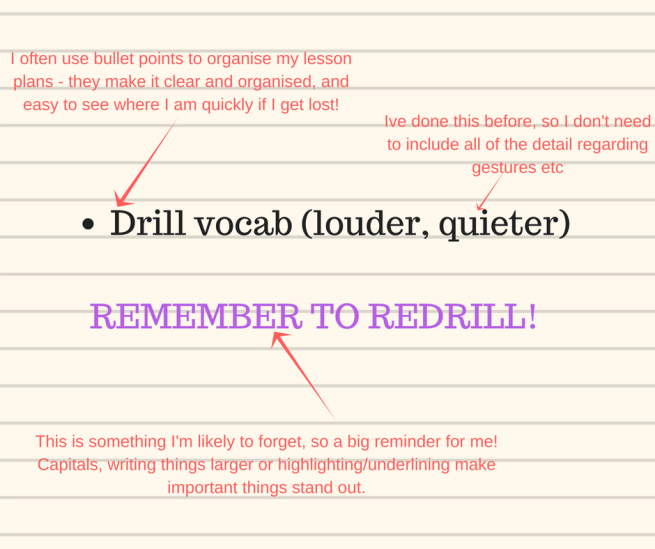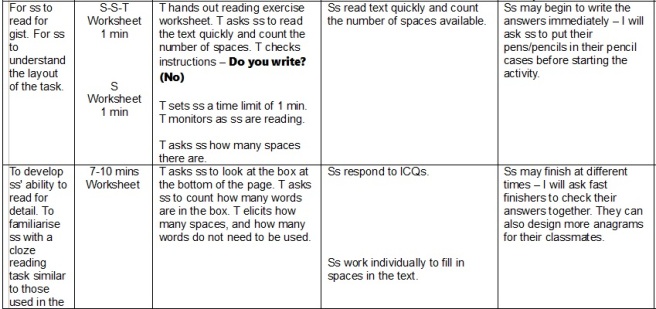
During your CELTA or Trinity, planning takes hours. Literally hours. It’s not so much the figuring out what you and your students are going to do, but more the writing an incredibly detailed procedure of every stage within that. It has, in the past, taken me around 4 hours to plan a single 45 minute lesson, which, let’s face it, is not sustainable when you’re teaching 18, 20 or even more hours a week.
Are you staring at your computer screen now with an expression of abject horror wondering when you’re ever going to have time for all your planning?
Or are you fed up with spending all weekend, every weekend, in the staffroom or at home, but poring over coursebooks?
It doesn’t have to be that way. Let’s talk about planning on a daily basis. In this post I’m going to share some sections of lessons I’ve planned to observation standard, and compare them to what my planning might look like if I were teaching that same lesson on a ‘normal day’. I’ll share some of the tricks and tips I use to keep my planning time down, and some advice on how you can make them work for you. Are you sitting comfortably? Have you got your coffee/tea/wine/beverage of choice? Then let’s begin.
Tip 1: Your plan is for you.
When you’re writing a plan for an observed lesson, your aim is to write a plan that could easily be followed by another teacher. On a normal day-to-day basis though, your plan is for you and you alone to follow. This means that it can look however you want, and can include whatever you want; it doesn’t need to be a clone of mine or a clone of anyone else’s. If you find a style that works for you, then stick to it.
Tip 2: Use abbreviations (but make sure you remember what they mean!)
You’ll notice that in my plans I rarely use full sentences, and often don’t use full words either. When you’re trying to save time, abbreviations are your friends. Students becomes ‘Ss’, feedback becomes ‘fb’, student book becomes ‘sb’, whatever floats your boat. A word of warning though – I have on occasion written things and then realised, when looking back, that I have no idea what my abbreviations mean. Choose something and then stick to it!
Tip 3: Use different colours, capitals, highlighting, underlining, and draw arrows and boxes round things.
Again, another little presentation tip. Observation lesson plans are usually typed – easier to read, change, email, and reproduce. However most people I know normally plan their lessons by hand. This means that you’re free to draw, doodle, and use different things to make different sections stand out. As long as it’s clear enough for you to read easily, anything goes.
Tip 4: You don’t have to write everything – but write the things you tend to forget!
One of the reasons observation lesson plans are so time-consuming is that you have to write every single little thing down. When planning for your normal lessons, you don’t need to! To state the obvious for a moment though, if there’s something you often forget to do, make a habit of including it, in writing, in your plan. For me it’s instruction checking/concept checking questions. If you do it often enough, it becomes a habit, but having a little written reminder doesn’t hurt when you’re on the way there.
Tip 5: You don’t need to include the same amount of detail for everything.
As with not needing to write everything down, you also don’t need to include the same amount of detail for everything. Write a more detailed written plan for activities that are complicated, or new to you or to your students. If it’s something you’ve done hundreds of times before, one or two words is enough.
Tip 6: Keep it all together.
One thing I can’t recommend enough is using some kind of dedicated notebook or exercise book for your lesson planning. Sure, it means you have to go to the trouble of buying one and then remembering to use it, but it does have multiple advantages over using individual bits of paper. First, it means that you’re less likely to lose your lesson plan before the lesson (I did this once, several years ago. Never again). Second, it means that you can easily refer back to things you did in previous lessons – helpful if your class is once or twice a week and by the time it rolls round again, you can’t quite remember! Thirdly, it gives you a helpful place to jot down notes during the class – activities that work well or don’t work well, students who find a particular topic or task difficult, things you need to revisit or do in the next lesson, or even simply who has forgotten their homework!
Tip 7: Don’t be afraid to use more space.
This ties in with the previous idea, but remember that you need to be able to read your lesson plan, and ideally be able to glance at it quickly and find what you need. When I first started teaching I would use my exercise book as a standard school exercise book – finish one plan, draw a line, start another one. I quickly found that my brain simply doesn’t work well this way, and so what works best for me is to use one page per lesson. Even if it’s not as good for the environment, and even if my plan is only five lines long, it helps me to focus on that one lesson and easily access the information I need. Don’t worry about wasting paper if wasting a little paper makes your life that much easier.
Tip 8: You don’t have to plan day by day, but don’t plan too far in advance either.
Some teachers I know try to get all of their planning done on the weekend, or on Monday, and so they are planning free for the rest of the week. If that works for you, then fine – but personally I’m always wary of planning too far in advance. If your schedule doesn’t allow for you to sit down and plan every single day, then of course don’t do that – work out when you’re free and figure out what days you can plan when. Bear in mind, though, that if you’re planning more than two lessons in advance with a particular group of students, you’re dependent on their learning fitting in perfectly with your plan. If your lessons follow on from one another, your students will need to understand and be able to use whatever you’ve taught them on Monday to be able to achieve your learning objectives for Wednesday. If they didn’t get it on Monday that means you’re likely to need to adapt Wednesday’s plan so that you go over the material again, give them more practice, or present it in a different way before moving on.
Tip 9: Figure out when you plan best.
This will be different for everyone – and may well depend on the hours you’re teaching too. In Russia, I taught predominantly in the afternoons and evenings, and so this meant I could use my mornings for planning time. On a few occasions I tried to plan in the evening, but found that by the time my lesson rolled round that what I’d written was a load of crap! On moving to Prague, however, I started teaching at 8am every day, following a 45 minute commute. I was not planning before that, and so my planning time switched to afternoon/evening. Given the choice, I still prefer to plan my lessons during the morning, but you might need to shift it around so that it works for you.
Tip 10: Be organised!
All the planning in the world isn’t going to help if you don’t finish the preparation process! When you’re planning your lesson, ideally have a ‘photocopy folder’ ready (this can just be a poly pocket!) and make copies of what you need as you’re going along. If you’re planning at home/in a coffee shop/anywhere else that you don’t have access to the resources you need or a printer/photocopier, make yourself a little ‘To Copy’ list. Check you’ve got all the materials you need – or again add them to your list of things you need to sort out before the class. Check CDs, website links, or any technology you might be using to prevent last-minute panics when you get into the classroom!
Now that we’ve talked about ways you can keep your planning time down, let’s see how all of those things work in practice.
Here’s an extract from a lesson where I was teaching a group of 6-7 year olds some new vocabulary. As you can see it follows the standard layout for observation lessons: stage aims, interaction patterns materials and time taken, what will the teacher be doing, what will the students be doing, potential problems and solutions. There’s a lot of information here (for only 2 minutes of activity!) and it shouldn’t be surprising that most of this wouldn’t make it into my lesson plan. Just because it’s written down doesn’t mean I haven’t thought about it, but this way of practising new vocabulary is a routine activity in my class and most of this information is in my head!

Here’s that same extract how I’d be likely to write it in a normal, non-observation lesson plan. Yup, that’s it!

Moving onto a ’20 questions’ type game now (this time played with a class of 10-12 year olds), here’s my observation plan extract.

And on a normal day:

Part of the reason I’ve written so little for both of these activities (one short bullet point a piece) is that I’ve done them multiple times before. They’ve become routine as much for me as for my students, and I don’t need to write out the whole procedure in order to know what I’m doing! Here’s a slightly different one though – an activity we haven’t done before, and a reading activity that I’m carefully staging to ensure my students have enough support.

As you can see, for this unfamiliar activity I’ve written far more. Some reminders to me (eg. tell the students to put their pens and pencils in pencil cases before the start of the activity), a time limit for an activity, some instruction checking questions, some answers to instruction checking questions! I often write down instruction checking questions/concept checking questions as it’s a good reminder to me to ask them!
I’ll also write down the answers to questions (either ICQ, CCQ or questions the students will be answering if the answers aren’t really obvious. I personally find maths and any kind of number work a struggle so tend to write down the answers to anything like that – it means I’m not suddenly having to count quickly in class and potentially getting it wrong!
I’ve also included my activity for fast finishers at the bottom: I find it helpful to have a reminder of things like that as often I’ll be so busy concentrating on the main activity that I’ll forget!

Finally, I’m just going to reiterate the most important point in this whole blog post – the planning you do on a daily basis is for you. It can look however you want it to, and take whatever form you want it to, and it doesn’t need to look like anyone else’s. Some people will naturally write longer, more detailed plans, while others will write less.
Don’t spend hours working out and writing down every little detail if it isn’t necessary and isn’t going to help you in the classroom. Planning is only preparation for the most important part: the teaching!
What do your lesson plans look like on a normal day-to-day basis?

In answer to your question 🙂 http://wp.me/p18yiK-1w4
LikeLike
Thanks for this post – it’s really helped put things into perspective for me. I was an English Language Assistant a couple of years ago in France (not too much planning as it was at secondary level) and I’m now teaching English in a university in Lyon and at times feel like planning takes over my life! I personally write quite detailed lesson plans and do re-use lessons to save on the planning time, but find that locating resources is often the time consuming part of planning – finding an appropriate video at the right level or a suitable text. If I require a large volume of photocopies I have to send these to print two weeks in advance, so it means I plan my lessons quite far in advance, or at times (like now!) simply plan lessons which don’t require photocopies. The tough part for me is balancing the planning with the paperwork and marking, which at times can get ridiculous. On the plus side, I’m improving my French and the opportunity to travel makes it worth it!
LikeLike
Glad to hear you enjoyed it Rosie – I’ll be checking out your blog as I also studied French at uni, although went the studying route rather than working as a language assistant. Part of me definitely wishes I’d headed back to France after graduating! 🙂
Elly x
LikeLiked by 1 person
Your blog is a wealth of information, glad to have stumbled upon it! Nice to meet a fellow French graduate – where did you study in France out of interest? 🙂
LikeLike
In Rennes – Université Rennes II to be precise. My French is now unfortunately horribly rusty as I’ve used it so little in the last six years 😦
LikeLiked by 1 person
I’m hoping I’ll be able to keep mine up when I head back to the UK at the end of this year! I don’t want to lose it after all the time I’ve put into learning it 🙂
LikeLike
Great post Elly, thanks for sharing all these useful ideas!
LikeLike
Lovely and extremely helpful post!
Thank you very much, Elly! 🙂
LikeLike
You’re welcome Juliana! Glad you’ve found it helpful 🙂
LikeLike
Interesting facts and extremely helpful for new starters…I couldn’t have said it any better!!!!:)
LikeLike
Thanks Alexandra! 🙂
LikeLike
Thank you so much! Following your tips makes lesson planning easier, especially if you are given multiple grade levels to handle. 🙂 I used to finish my lesson plan for the whole school year before the new school year starts because I am afraid that I might not be able to consistently do it every week. However, after reading this, I realized that I should keep in mind that I am planning for my students to learn, and not just to beat the deadline (and for the sake of submitting one).
LikeLiked by 1 person